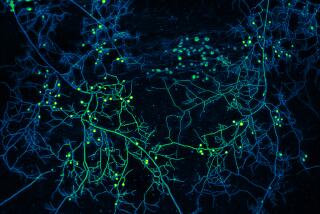Fungus Shows Dynamite Potential for Environment
- Share via
BEAVERTON, Ore. — The letters TNT and PCB mean danger to people. But to a common forest fungus, they mean dinner.
White rot fungus “eats” the chemical compounds that make up the explosive TNT and cancer-causing PCBs, and turns them into harmless carbon dioxide and water.
Scientists are trying to find out what else they can put on the fungus’ menu, now that researchers at the Oregon Graduate Institute have figured out how the organism works.
Their results were published in the January issue of Applied and Environmental Microbiology.
The U.S. Environmental Protection Agency is especially interested.
“Is it going to be a silver bullet for us? I sure can’t say at this point,” said John Barich, an EPA researcher at the agency’s regional office in Seattle.
“But we’re certainly extremely interested in any bioremediation schemes,” Barich said. “In general, in that field of research and product development, they’ve started slowly but they’re finding they’re getting better and better results.”
Bioremediation is the word scientists use for cleaning up the environment with living organisms such as bacteria, and now, fungi. However, biological agents have remained mostly experimental with little commercial value.
“The most promising market for bioremediation so far has been to clean up oil and gasoline spills,” said Owen Kean, spokesman for the Chemical Manufacturers Assn. in Washington, D.C.
But Michael Glaser at the EPA’s Risk Reduction Engineering Laboratory in Cincinnati has already used the fungus to break down wood-product waste at a former mill site in Brookhaven, Miss.
“I don’t want to oversell it, but it looks promising,” said Glaser. “We already have the fungal technology in the field and have it working at a scale that might prove useful.”
Glaser said initial data at the site showed that white rot fungi removed up to 85% of toxic pentachlorophenol within 56 days. The chemical was used with creosote to treat telephone poles to make them resistant to decay.
The fungus, which is found in North America, Russia and Scandinavia, apparently breaks down the toxic chemicals much the way it does lignin, a natural substance that gives wood its strength.
“It was a fortuitous discovery,” said research team leader Michael Gold, who has been studying lignin for more than 15 years.




